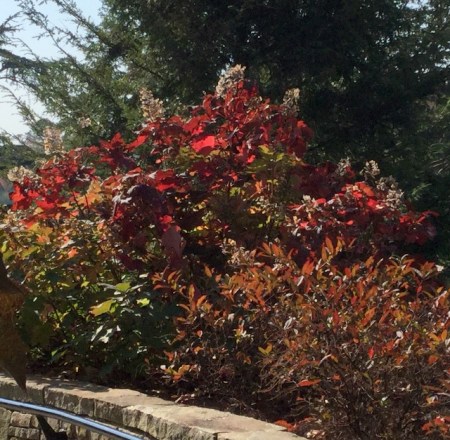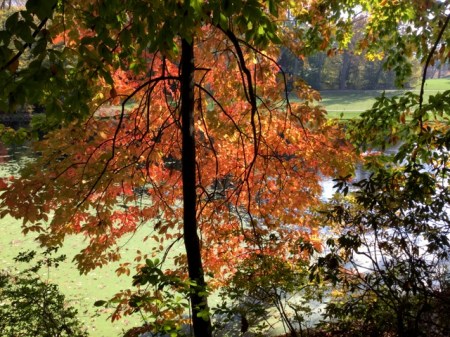
A view across the lake of the color in Peirce’s Woods, an area of native plants.
We have been having one of the most beautiful falls that I can remember. Every day is bright and sunny, between 50 and 60 degrees F (10 to 15.6 degrees C) except when we have just the right amount of rain. The fall color on trees, shrubs, vines, and perennials is spectacular. I am blessed to live in an area where I can enjoy one of nature’s most majestic shows just by walking outside my door. So I decided to post photos for gardeners in the US and abroad who don’t experience this amazing prelude to winter.
Nursery News: Carolyn’s Shade Gardens is a retail nursery located in Bryn Mawr, PA, specializing in showy, colorful, and unusual plants for shade. The only plants that we ship are snowdrops and miniature hostas. For catalogues and announcements of events, please send your full name, location, and phone number (for back up use only) to carolyn@carolynsshadegardens.com. Click here to get to the home page of our website for catalogues and information about our nursery and to subscribe to our blog.
.

Bald cypress, Taxodium distichum, native to PA.
All but two of these photos were taken during a visit to Longwood Gardens in Kennett Square, Pennsylvania, US, on November 2. Every plant is native to the US and most to Pennsylvania (PA), which is part of the mid-Atlantic. A similar color riot is still going on today, November 12, in my own PA garden.
.
Pitcher plants, Saracenia, native to PA, even the planters near Peirce’s Woods are filled with natives.
.

One of my top five shrubs: oakleaf hydrangea, H. quercifolia, and fall color is a big part of that along with gorgeous flowers, tropical-looking leaves, peeling cinnamon bark, and its status as a native albeit slightly south of PA.
.

The words “jewel-like color” were made for oakleaf hydrangea.
.

Flowering dogwood, Cornus florida, native to PA, one of the best small trees for fall color not to mention spectacular flowers and fruit as well as a unique and elegant habit. This is a young specimen.
.

Bottlebrush buckeye, Aesculus parviflora, a PA native with beautiful flowers in the late spring. Great for creating a grove in dense shade and dry soil.
.

Fothergilla, F. gardenii, native just south of PA, provides a mix of oranges, reds, and yellows that lasts a long time. In the spring it sports lovely fragrant flowers.
.



 ‘Prairie Sentinel’ pond cypress, Taxodium ascendens, has a more upright habit than its cousin the bald cypress and is native just south of PA.
‘Prairie Sentinel’ pond cypress, Taxodium ascendens, has a more upright habit than its cousin the bald cypress and is native just south of PA.

I had to throw in this photo from Carolyn’s Shade Gardens of ‘Hartlage Wine’ allspice, Calycanthus raulstonii. Top five shrubs again with absolutely gorgeous, bright yellow fall color; long-lasting, exquisite, large red flowers; and big, shiny, smooth blue-green leaves. It is a native hybrid.
.

Also from Carolyn’s Shade Gardens, another favorite tree native to PA, yellowwood, Cladrastis kentukea.
.
Carolyn
.
Nursery Happenings: You can sign up to receive catalogues and emails about nursery events by sending your full name and phone number to carolynsshadegardens@verizon.net. Subscribing to my blog does not sign you up to receive this information. Please indicate if you will be shopping at the nursery or are mail order only.
Carolyn’s Shade Gardens is a local retail nursery in Bryn Mawr, Pennsylvania, U.S., zone 6b/7a. The only plants that we mail order are snowdrops and miniature hostas and only within the US.
Facebook: Carolyn’s Shade Gardens has a Facebook Page where I post single photos, garden tips, and other information that doesn’t fit into a blog post. You can look at my Facebook page here or click the Like button on my right sidebar here.
Notes: Every word that appears in orange on my blog is a link that you can click for more information. If you want to return to my blog’s homepage to access the sidebar information (catalogues, previous articles, etc.) or to subscribe to my blog, just click here.


























